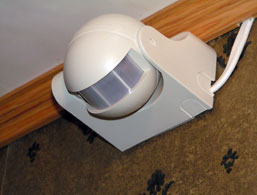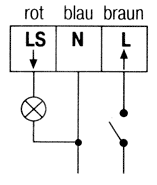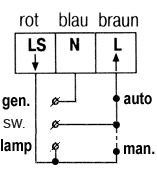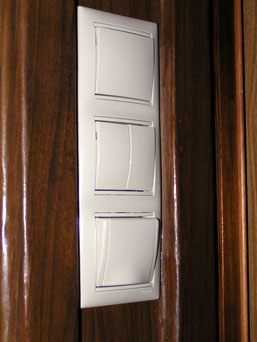The automatic switch of illumination
In this article I shall tell to you as it is possible to make
automatic control of illumination on the basis of the gauge of movement.
(Translation from Russian)
 At last that on sale were inexpensive gauges of movement! In Petersburg shop OBI
I have casually come across the gauge of movement of firm
Duewi which cost less
than 200 roubles.
At last that on sale were inexpensive gauges of movement! In Petersburg shop OBI
I have casually come across the gauge of movement of firm
Duewi which cost less
than 200 roubles.
On a picture the gauge of model Control Lux established under a ceiling
is represented. This firm lets out gauges in cases of white and black colors.
The gauge of movement is the passive infra-red switch which reacts to movement
of a source of heat. Such gauge is convenient for establishing on a summer
residence before an input in the house or in a toilet. Except for economy of the
electric power and increase of comfort, the gauge can frighten thieves also.
The built in photo cell interferes with job of the gauge in the afternoon.
The threshold of light exposure at which the gauge starts to work can be
adjusted. The gauge also allows to adjust a delay of deenergizing in a range
from 0,5 till 12 minutes. The corner of detection of this model of the gauge
makes 110 degrees (there is a model more expensively with a greater corner of
detection). Radius of detection - 12 meters. The degree of protection IP 44
allows to establish the gauge in the street, but certainly to establish it under
any canopy that
the rain did not pour on the gauge directly is better.
 Installation of the gauge does not represent any problems. It is enough to
connect a pressure and a lamp to contacts of the gauge as it is represented on
the scheme on the right. If you do not need deenergizing the gauge the switch
can be excluded from the scheme.
Installation of the gauge does not represent any problems. It is enough to
connect a pressure and a lamp to contacts of the gauge as it is represented on
the scheme on the right. If you do not need deenergizing the gauge the switch
can be excluded from the scheme.
After installation of the gauge it is necessary to adjust only if necessary a
threshold of light exposure for the beginning operations of the gauge and a
delay of deenergizing. If the gauge is established in a toilet the delay
approximately 2-3 minutes is quite sufficient.
Probably you will want to put the automatic switch in a corridor, in a toilet
and in the Bathroom. Unfortunately, to lie down in Bathing long time without
movement to you it will not be possible - light will be switched off. Certainly,
in a bathroom it is better to apply the gauge of volume, but he very dear. That
all to use in bathing the cheap gauge of movement, it is possible to finish a
little the scheme, having added in it an opportunity of manual inclusion of
illumination. Then, if you want to take a bath, you will need to include in a
bathing manual mode, and in all other cases of job of automatics it is quite
enough.
 For completion of the scheme represented at the left, the electric switch is
required. I managed in Petersburg to find only two models of such switches of
firm
Legrand. In assortment of firm is one and two keyboard switches. The scheme
works as follows. When the switch is in position "auto", the lamp is included through
the gauge of movement. If the switch is in manual position a feed of the gauge
is disconnected also a lighting lamp burns constantly.
For completion of the scheme represented at the left, the electric switch is
required. I managed in Petersburg to find only two models of such switches of
firm
Legrand. In assortment of firm is one and two keyboard switches. The scheme
works as follows. When the switch is in position "auto", the lamp is included through
the gauge of movement. If the switch is in manual position a feed of the gauge
is disconnected also a lighting lamp burns constantly.
 To mount the given scheme simply. To pull any additional wires to a lamp it is
not required. To connect contacts "general" and the "lamp", represented on the
scheme to wires in your distributive box which go to your old usual switch
enough. Usually in a corridor in one place there is two or three keyboard switch,
therefore to find the general wire it is possible, he goes on the general
contact of such switch.
To mount the given scheme simply. To pull any additional wires to a lamp it is
not required. To connect contacts "general" and the "lamp", represented on the
scheme to wires in your distributive box which go to your old usual switch
enough. Usually in a corridor in one place there is two or three keyboard switch,
therefore to find the general wire it is possible, he goes on the general
contact of such switch.
In a photo that has turned out at us on the right is visible. The top single
switch allows to switch a manual and automatic mode for a corridor. Two average
keys operate manual and automatic modes in bathing and a toilet. In the bottom
of the block under cover
there is a socket. These switches we practically do not use. Automatics, which
gauges cost in a corridor, a toilet and a bathroom, provides the maximal comfort
of management with illumination almost always.
And at last one remark. Before establishing the gauge finally on
the place, fix it temporarily (for example, an adhesive tape) and necessarily
test job of system. Bypass a prospective cover zone, be convinced, that the
gauge works in the points necessary to you, correct a corner of an inclination
of the gauge. A chance when the place which you have provided under the gauge
does not approach for it. For example, if the lamp is close from the gauge the
gauge can work from heat of a lamp which he has included and thus deenergizing
of illumination will not occur. Only after you were convinced, that the system
of illumination works how it is necessary for you, drill apertures under the
gauge and establish it finally. If you need to reduce a corner of the review of
the gauge the part of its window can be closed, for example a foil.
Marabou, 18.09.2007
|




 At last that on sale were inexpensive gauges of movement! In Petersburg shop OBI
I have casually come across the gauge of movement of firm
At last that on sale were inexpensive gauges of movement! In Petersburg shop OBI
I have casually come across the gauge of movement of firm
 Installation of the gauge does not represent any problems. It is enough to
connect a pressure and a lamp to contacts of the gauge as it is represented on
the scheme on the right. If you do not need deenergizing the gauge the switch
can be excluded from the scheme.
Installation of the gauge does not represent any problems. It is enough to
connect a pressure and a lamp to contacts of the gauge as it is represented on
the scheme on the right. If you do not need deenergizing the gauge the switch
can be excluded from the scheme. For completion of the scheme represented at the left, the electric switch is
required. I managed in Petersburg to find only two models of such switches of
firm
For completion of the scheme represented at the left, the electric switch is
required. I managed in Petersburg to find only two models of such switches of
firm
 To mount the given scheme simply. To pull any additional wires to a lamp it is
not required. To connect contacts "general" and the "lamp", represented on the
scheme to wires in your distributive box which go to your old usual switch
enough. Usually in a corridor in one place there is two or three keyboard switch,
therefore to find the general wire it is possible, he goes on the general
contact of such switch.
To mount the given scheme simply. To pull any additional wires to a lamp it is
not required. To connect contacts "general" and the "lamp", represented on the
scheme to wires in your distributive box which go to your old usual switch
enough. Usually in a corridor in one place there is two or three keyboard switch,
therefore to find the general wire it is possible, he goes on the general
contact of such switch.